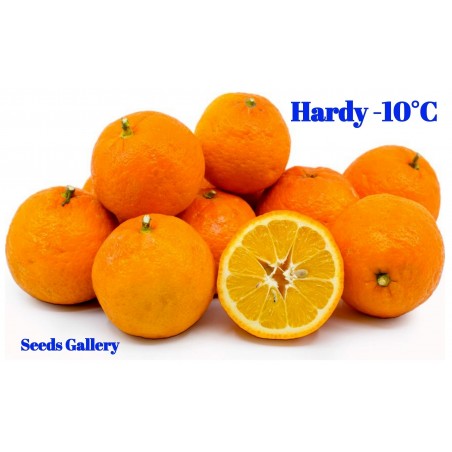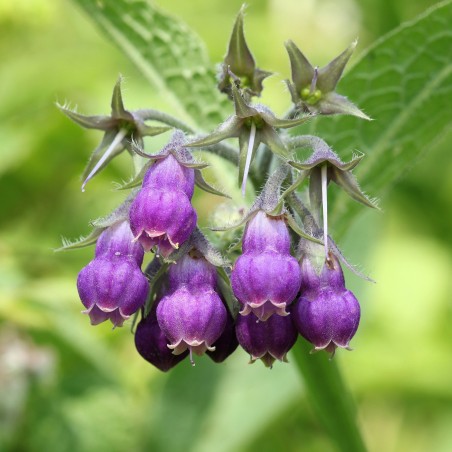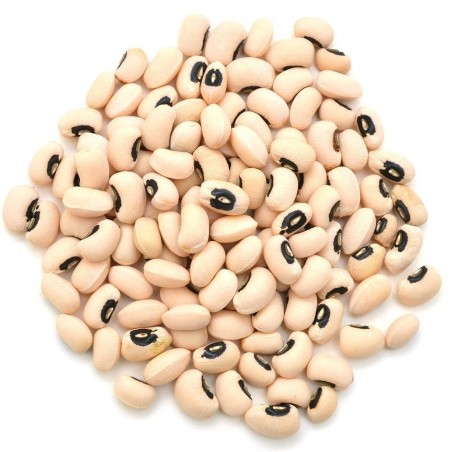
Comfrey Seeds (Symphytum officinale)
Comfrey Seeds (Symphytum officinale)
Price for Package of 5 seeds.
One of the most useful plants on the allotment with the widest range of uses in a permaculture system of any plant. Comfrey is a herbaceous perennial herb with large, hairy leaves and grows in a rosette to 1 m (3’4”) in height. The mauve flowers are bell-like and borne in clusters that are extremely attractive to insects. The leaves are a useful addition to compost or used as mulch, as they contain silica, nitrogen, magnesium, calcium, potassium, and iron. Comfrey leaves are about 17% nitrogen (horse manure is about 14%) and the leaves readily decompose when soaked in water to make organic liquid manure. Comfrey grows in any soil, preferably moist, in the sun or part shade.
- Sow from March to June in a seed-bed or in pots indoors. The seed benefit from being placed in a chilled environment (fridge) for 14-28 days to activate the seed prior to sowing, hence improving germination rates.
- Sow seeds thinly, 12mm (½in) deep in drills 30cm (12in) apart. Can also be sown in pots or trays under glass and transplanted.
- Transplant when large enough to handle to 60cm (2ft) apart between plants
- Keep well-watered until established. Leaves can be cut regularly throughout the summer and autumn.
WIKIPEDIA:
Symphytum officinale is a perennial flowering plant in the family Boraginaceae. Along with thirty four other species of Symphytum, it is known as comfrey. To differentiate it from other members of the genus Symphytum, this species is known as common comfrey[1] or true comfrey.[2] Other English names include Quaker comfrey, cultivated comfrey,[2] boneset, knitbone, consound, and slippery-root.[3] It is native to Europe, growing in damp, grassy places. It is locally frequent throughout Ireland and Britain on river banks and ditches. It occurs elsewhere, including North America, as an introduced species and sometimes a weed. The flowers are mostly visited by bumblebees.[4] Internal or long-term topical use of comfrey is discouraged due to its strong potential to cause liver toxicity.[5]
History
Over centuries, comfrey was cultivated in Asia, Europe, and the United Kingdom as a vegetable and herbal medicine.[5][6][7] Its early common names, knitbone or boneset, reflect its historical use by poultices of leaves and roots to treat sprains, bruises or bone fractures.[5][6]
Description and botany
Comfrey is a perennial plant found in moist grasslands in western Asia, Europe, and North America.[7] The hardy plant can grow to a height of 1–3 ft (0.3–0.9 m).[7] It is a perennial herb with a black, turnip-like root and large, hairy broad leaves that bears small bell-shaped flowers of various colors, typically cream or purplish, which may be striped.
A common hybrid is formed between Symphytum officinale and S. asperum, Symphytum × uplandicum, known as Russian comfrey, which is widespread in the British Isles, and which interbreeds with S. officinale. Compared to S. officinale, S. × uplandicum is generally more bristly and has flowers that tend to be bluer or violet.[8] The plant produces significant nectar when compared to other UK plants tested.[9]
Traditional medicine
In folklore, Symphytum officinale roots were used in traditional medicine internally (as an herbal tea or tincture) or externally (as an ointment, compresses, or alcoholic digestion) for treatment of various disorders,[5][7][10] including commonly as a treatment for reducing the pain of osteoarthritis.[11] A 2013 review of clinical studies assessing the possible effect of comfrey on osteoarthritis found the research quality was too low to allow conclusions about its efficacy and safety.[11] In Europe as of 2015, there were no comfrey products for oral use, and those for topical uses to treat bruises or joint pain were evaluated as having risk of liver toxicity.[6]
Toxicity and adverse effects
Comfrey contains pyrrolizidine alkaloids which are toxic compounds readily absorbed via the stomach or skin, and have the potential to increase the risk of fatal liver toxicity.[5][6][12] In 2001, the US Food and Drug Administration and Federal Trade Commission banned the sale of comfrey products from the market due to its potential toxicities.[13][14] A 2018 review on pyrrolizidine alkaloids present in comfrey indicated widespread potential toxicity to humans and livestock and the opportunity for drug development from these compounds.
| HEIRLOOM ? | Yes |
|---|---|
| Organic Seeds ? | Organic Seeds |
| Pretreatment of sowing ? | Soak in water before sowing 12-24 h Stratification needed: Yes |
| Sowing depth ? | Sowing depth 1 cm |
| Life Cycle: | Perennial plant : Yes |
| Handpicked seeds ? | Handpicked seeds |
| Resistant to cold and frost ? | Resistant to cold and frost |
| Manufacturer ? | Manufacturer: Seeds Gallery |
| Medicinal Plant ? | Medicinal Plant: Yes |


Your review appreciation cannot be sent
Report comment
Report sent
Your report cannot be sent
Write your review
Review sent
Your review cannot be sent
🌍 Worldwide Shipping from the EU
We ship worldwide from the European Union using registered air post with signature confirmation on delivery.
📦 Tracking Your Order
Log in to your account and go to Order History > Details to find your tracking number.
You will receive email notifications at every step — please check your spam/junk folder if you don’t see them.
Track your package via:
⚠️ Important Notices
Cash on delivery is not available.
Always provide a valid mobile number with country code when ordering (e.g., +365 456 7686 576).
Do not order to P.O. Boxes or if you cannot be home to sign for the package. We cannot leave parcels with neighbors.
If a package sent to a P.O. Box is lost or undelivered, you lose the right to a refund.
📦 Lost, Returned & Reshipping Packages
For customers in Brazil and Mexico:
We cannot refund packages lost or destroyed by customs.
If your package is returned, we will refund only the product cost — shipping costs are not refundable.
You must pay return postage (€2) and any costs for reshipping.
If a package is returned to us for any reason, you are responsible for paying the return shipping (€2) plus the cost to resend the package.
🚚 Shipment Delivery
Registered shipments require a signature from the recipient.
If your tracking shows the package is still at the origin post office, it means the package is in transit — please contact your local post office directly for updates.
We are not responsible for delivery times and cannot track shipments for you.
📅 Delivery Options & Estimated Times
Delivery Option Processing Time Notes Priority Delivery Ships in 1-7 business days Prioritizes order processing (not guaranteed faster delivery); delays possible during holidays (3-10 days) Secured Delivery Ships in 1-7 business days Available for orders up to €150; refund if lost Standard Delivery Ships in 7-10 business days More economical; delays possible during holidays (7-14 days) Estimated Delivery Time:
Within the EU: 3–20 days
Worldwide: 5–30 days
Example delivery times to the USA:
Delivered in 13, 17, 19, 22, or 27 days.Note: Delivery times depend on your location and the local postal system. COVID-19 may cause additional delays.
💰 Shipping Costs
Shipping and handling fees are calculated automatically during checkout based on the weight of the parcel and the destination country.
⏰ Order Processing Hours
We do not process or ship orders on Saturdays or Sundays.
💳 Payment Options
Bank Transfer (SEPA / IBAN / SWIFT-BIC)
Include your order reference in the payment description (e.g., "SGS-19811702"). Orders without payment within 7 days are automatically cancelled.PayPal
Payments accepted in Euros only. Please select Euros at checkout.Card Payment
For card payments, visit our other site: Exotic Seeds Store
We accept Visa, MasterCard, American Express, CB, Diners Club, Discover, China UnionPay, JCB, and Discover.
⚠️ Transaction Fees
Customers are responsible for any transaction fees. Please provide payment details to help us process your order efficiently.
📢 Final Notes
Before placing your order, please check our website for any special notices, holiday schedules, or specific conditions that may affect your purchase.
Related Products















